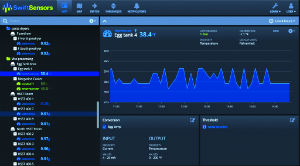Wireless rides shotgun
Of course, once Ethernet began popping up in process applications, it was closely followed by related wireless formats such as WiFi and Bluetooth, which joined the radio, cellular and satellite technologies that were already widely deployed. And, because Ethernet paves the way for the Internet, IIoT can also expand via wireless.
Likewise, Kraft Heinz Co.‘s plant in Champaign, Ill., has long used PLCs to manage operations and raw material/product refrigeration, but it didn’t have enough sensors with real-time monitoring, notifications and alerts of out-of-range temperatures, and often resorted to paper chart recorders that had to be manually checked. As a result, Kraft Heinz engineers recently installed matchbox-sized, battery-powered wireless temperature sensors from Swift Sensors, which send data to a wireless bridge that relays it via secure Wi-Fi to a cloud service for uniform display on a common dashboard available on PCs and mobile devices.
Better temperature monitoring and improved productivity encouraged Kraft Heinz to add wireless vibration sensors to motors on its pumps and compressors, and provide real-time alerts to quality assurance and maintenance staff about changes in their performance without altering existing equipment. The latest wireless device deployed at the Champaign plant is Swift Sensors’ 4-20 mA sensors that are linked in a 4-20 mA current loop from RTD sensors used with the PLCs. The 4-20 mA sensor let users pull data from existing transducers and sensors connected to existing PLCs using the standard 4 – 20mA current loop, and this delivers real-time updates from all sensors in the plant to one cloud-based dashboard viewable on PCs, tablets or smartphones (Figure 4).

Figure 4: Wireless, 4-20mA sensors deployed at Kraft Heinz’s plant in Champaign, Ill., are connected in a 4-20 mA current loop from RTD sensors and PLCs controlling operations, refrigeration and motors. They deliver data to a bridge and cloud service that displays it on a common dashboard, which users can view on PCs, tablets and smartphones. Source: Kraft Heinz and Swift Sensors
Kraft Heinz reports automatic data logging and reporting by its new wireless network reduced its return on investment (ROI) to just five months, while immediate notifications have aided its food safety and saved hundreds of thousands of dollars of raw materials and finished products.
Sam Cece, founder and CEO of Swift Sensors, reports that users can deploy its 50 wireless, IP-enabled sensors as needed, display their information on the same dashboard, and even integrate video from Eagle Eye security sensors. “IoT can help as users deploy more temperature, humidity, 4-20 mA, water presence, electricity, vibration and other sensors,” he says. “But, as they also generate more unstructured data, our interface can present it all in the same way, allow thresholds to be set for each, overlay and combine their data for better insights. This replaces some former tribal knowledge with sensor data and thresholds shown on smart phones. This isn’t talked about as IoT, but that’s what’s happening.”
In the News
Covered on these news sites. Click image to read more.

